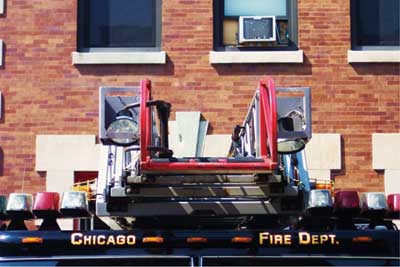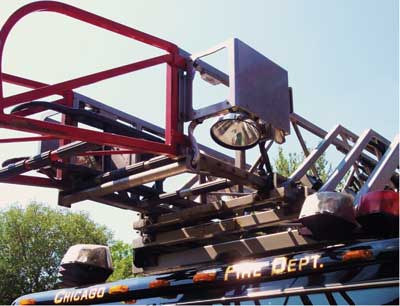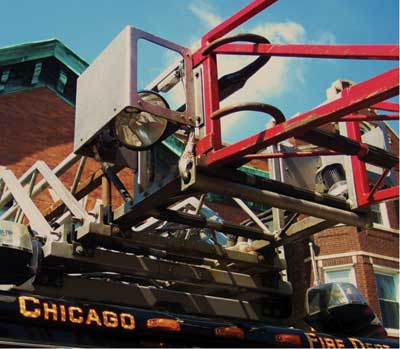By TOM SUTKUS
Most truck companies have two sets of floodlights mounted to the aerial ladder. The first set is usually at the base of the ladder near the turntable. The second set will be at the tip of the fly section. After dark, the two lights at the base illuminate the walkway and the outside beams of the ladder between the turntable and the tip. The lights can also assist the operator with ladder placement as the ladder extends toward its objective such as the structure or the roof. However, the farther the ladder is extended, the less effective these lights may be. This is where the second set of lights-at the tip of the fly section-will come into play. In addition to assisting the operator with ladder placement, they also have another purpose.
The vast majority of truck companies in Chicago and its outlying areas run with all four lights pointed straight ahead. Some drivers respond to calls with the aerial lights on. I once asked a driver why he drove with the lights on, and he said, “I want to be sure that people see me coming.” I don’t believe that blinding oncoming traffic is the best way to be seen. At the fire scene, pointing the tip lights straight ahead may briefly cast light in the direction the ladder is extending, but as the aerial is raised and positioned for roof operations, the lights at the tip will be pointed at the sky. This provides no value to the members operating on the roof. However, if the tip lights are angled differently, they can assist in positioning the ladder as well as illuminating the surface of the roof (photo 1).
 |
| (1) Rather than pointing the tip lights straight ahead, angling them will assist the members working on the roof. (Photos by author.) |
Depending on the manufacturer of the apparatus, the pedestal controls may be on the right side or left side of the aerial ladder. On the pedestal side of our aerial, we angled the tip light almost straight down. It’s not quite 90°; it is closer to 80° or 85°. This allows the operator to watch the light run up the side of the structure to the top of the parapet or the side of a pitched roof to the ridge. Once the light disappears over the parapet or the ridge, the operator knows for certain that the tip has reached its target. Extending the ladder another five to seven rungs makes it easier and safer for members to get on and off the roof and to see the ladder if smoke conditions obscure the edge of the roof. Additionally, the light adds a margin of safety by illuminating the area where the members will be stepping onto a flat roof (photo 2).
 |
| (2) The light on the pedestal side of the aerial will illuminate the parapet as the light passes over the coping or illuminate the roof as the light passes over the ridge. Once in place, it will cast light where members are stepping onto a flat roof. |
On the opposite side of the aerial ladder, we angled the tip light to about 45°. While the aerial is extending toward the roof, this light will help the operator with ladder placement by illuminating the objective being reached. Once the ladder is in place for operations, it will also cast light farther out onto the roof deck where members will be walking or operating (photo 3).
 |
| (3) The light on the left is at 45°. As the aerial is extending, it will cast light in the direction of the building and the roof. Once in place for operations, it will cast light in the direction that the members are working on a flat roof. |
To observe the light advancing up the side of the structure or the side of a pitched roof during daylight, the aerial will have to clear the target at a much closer range. Exercise caution so the tip does not come in contact with the parapet or ridge, especially if a prepiped waterway is mounted to the underside of the aerial. Experience and practice are the keys.
Note that the angle of the lights can be affected by the simple motion of the apparatus bouncing along the streets. If there are no protective guards around the lights, extending the aerial through obstacles such as tree branches may also reposition them. Operators should use care when moving and operating the aerial and always check the position of the lights when performing apparatus checks. If necessary during operations, the roof team can reposition the lights for better work area visibility.
The lights are placed on the aerial ladder for our convenience and safety. Let’s take advantage of them to operate more efficiently and to keep our people safe.
● TOM SUTKUS is a 33-year fire service veteran and a captain with the Chicago (IL) Fire Department, where he is assigned to Truck Company 32. Sutkus completed fire officer III and fire instructor III with the state of Illinois and has an associate degree in fire science from Chicago City-Wide College. He has been an instructor for the University of Illinois Fire Service Institute since 2002.
Fire Engineering Archives

